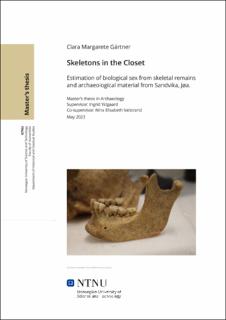| dc.contributor.advisor | Ystgaard, Ingrid | |
| dc.contributor.advisor | Valstrand, Nina Elisabeth | |
| dc.contributor.author | Gärtner, Clara Margarete | |
| dc.date.accessioned | 2023-07-18T17:21:53Z | |
| dc.date.available | 2023-07-18T17:21:53Z | |
| dc.date.issued | 2023 | |
| dc.identifier | no.ntnu:inspera:145532187:97788508 | |
| dc.identifier.uri | https://hdl.handle.net/11250/3080081 | |
| dc.description.abstract | Arkeologer har brukt gravgods for å trekke konklusjoner om biologisk kjønn i svært lang tid. Det har vært enkelttilfeller hvor disse konklusjonene har blitt bevist feil ved bruk av aDNA og andre vitenskapelige analysemetoder. Denne oppgaven forsøker å vurdere sammenhengen mellom gamle biologiske kjønnsestimeringer og nye biologiske kjønnsestimeringer med bruk av oppdaterte metoder. Samtidig blir forholdet mellom kjønnsbestemmelser basert på osteologiske levninger og arkeologisk materiale diskutert ved bruk av de menneskelige levningene fra sittegravene på Jøa som casestudie.
Av de 24 gravene på lokaliteten hadde 14 bevarte levninger. I denne oppgaven ble 14 levninger analysert, selv om det under analysen ble tydelig at det var noen utfordringer, som forsvunne individer og blandete levninger som ble angitt som bare ett individ i den opprinnelige utgravningsrapporten. Individene ble analysert sist på 1960-tallet, og etter å ha fullført analysen for denne oppgaven med nyere osteologiske metoder ble det tydelig at mange av estimatene av biologisk kjønn ikke stemte overens med de fra 1960-tallet. Dette tilsier at levninger som sist ble analysert for flere år siden bør analyseres på nytt for at informasjonen om levningene skal være oppdatert.
Fra sammenligningen mellom det biologiske kjønn estimert gjennom osteologisk analyse og det estimerte biologiske kjønn ved bruk av gravgods er det noen resultater som stemmer overens og noen som ikke gjør det. Dette kan skyldes metodene som ble brukt under den osteologiske analysen (de fleste individene hadde kun hodeskallen bevart, ikke bekkenet, så hodeskallen var ofte den eneste basisen for estimeringen av biologisk kjønn, men det kan også være en indikator på den teoretiske ideen om at biologisk kjønn og sosialt kjønn ikke er det samme og at sosialt kjønn ikke er den sosiale konstruksjonen av biologisk kjønn.
Det ble også tydelig at det faktum at Norge mangler standarder når det gjelder utgravning, dokumentasjon og kuratering av menneskelige levninger har ført til et betydelig tap av kunnskap over tid. Dette har blitt tydelig gjennom at det har vært problematikk rundt organisering og dokumentasjon av levningene, og det er få kilder som detaljerer tolkningene og beslutningene som ble tatt angående levningene gjennom hele utgravnings- og kurasjonsprosessen. | |
| dc.description.abstract | Archaeologists have used grave goods to draw conclusions about biological sex for an exceptionally long time. There have been individual cases where these conclusions have been proven wrong using aDNA and other scientific methods of analysis. This thesis attempts to evaluate the correlation between earlier osteological sex determinations and new osteological sex determinations with up-to date methods, and at the same time discuss the relationship between sex determinations based on osteological remains and archaeological material.
Out of the 24 graves at the site, 14 of them had preserved remains. This thesis looked at 14 individuals, though during analysis it became evident that there were some challenges, such as missing individuals and comingled remains that were indicated as only being one individual in the original excavation report. The individuals were analysed last in the 1960s and after completing the analysis for this thesis with newer osteological methods it became evident that many of the estimations of biological sex did not match up with the ones from the 1960s. This would indicate that older remains should be reanalysed in order for the information on the remains to be updated.
From the comparison between the biological sex estimated through osteological analysis and the estimations using grave goods some estimations match up and some do not. This could be due to the methods used during the osteological analysis (for most individuals only the skull was preserved, not the pelvis), but could also be an indicator of the theoretical idea that biological sex and social sex are not the same and that social sex is not actually the social construction of biological sex. It also became evident that Norway lacks standards for the excavation, documentation and curation of human remains has led to a significant loss of knowledge over time. This has become clear through the fact that there have been challenges surrounding the organisation and documentation of the human remains, and there are few sources that detail the interpretations and decisions that were made regarding the remains throughout the excavation and curation process. | |
| dc.language | eng | |
| dc.publisher | NTNU | |
| dc.title | Skeletons in the Closet: Estimation of biological sex from skeletal remains and archaeological material from Sandvika, Jøa. | |
| dc.type | Master thesis | |
